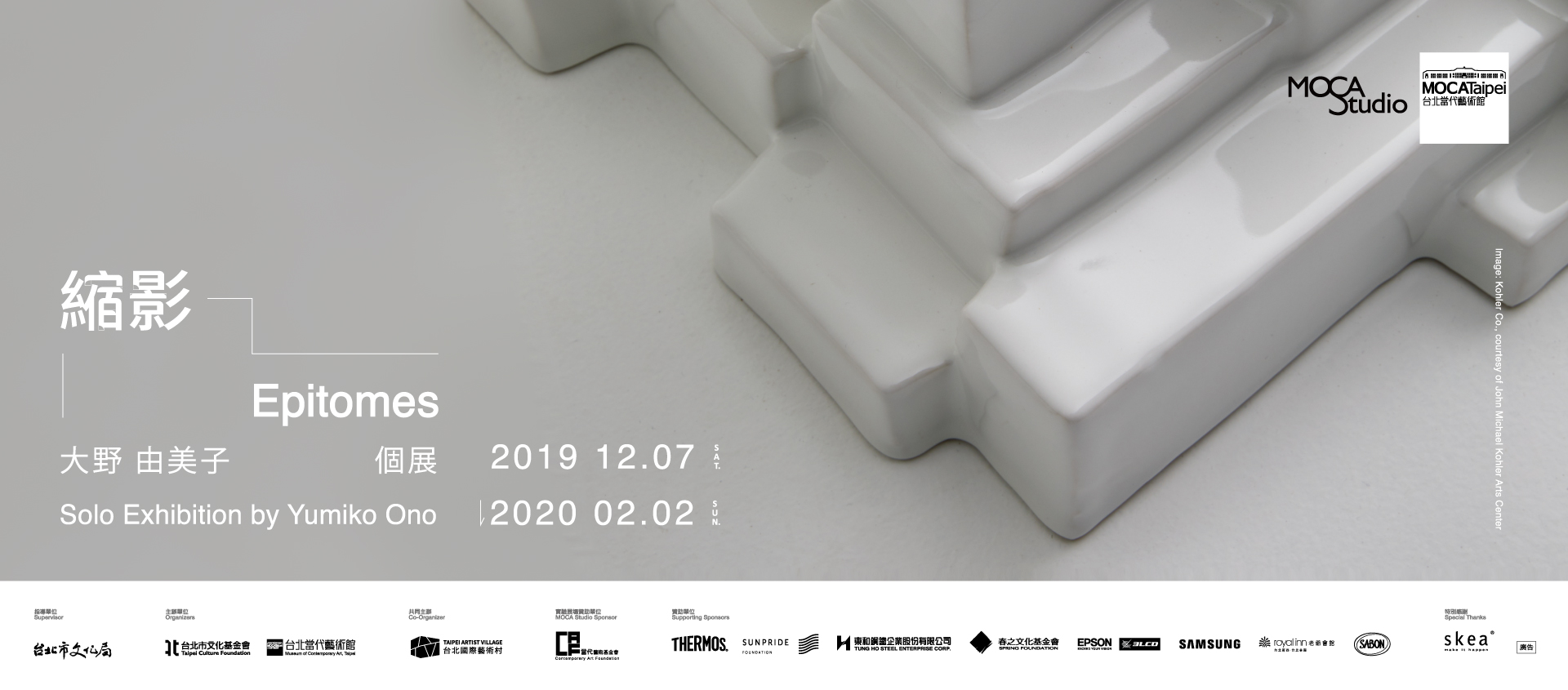

台北當代藝術館 官方網站 Museum of Contemporary Art, Taipei
Friday 星期五
10AM - 6PM



Friday 星期五
10AM - 6PM
EXHIBITIONS & EVENTS 展覽活動

2019 / 12 / 07 Sat.
2020 / 02 / 02 Sun.
10:00 - 18:00
地點
venue
MoCA Studio
中國詩人陶淵明的桃花源記中闡述,空靈的烏托邦是個如欲尋覓卻越無法尋得的地方。藝術家將此概念與「臺灣性 (Taiwanese-ness)」重疊,描述臺灣性也是一個存在於空間中但欲靠近卻無法實際碰觸的狀態。對她而言,代表著一個因擁有複雜的殖民歷史背景,而產生多層次與複雜的國家身分。與外來者有著深刻的連結,導致臺灣與其他影響者之間的界限模糊不清,甚至可以評斷為不存在,而此影響也在臺灣的建築中顯現,如此的狀態吸引了她,並對臺灣建築產生了興趣,並以此列為展覽的主題。
這幾年大野由美子以建築物件為靈感來源來創作素描與陶瓷雕塑,她蒐集在臺灣期間所見之建築以及其表面質地的影像,作為創作素材。在駐臺期間,她開始對紙紮的技術感興趣,她發現她創作中想像的建築體與紙紮間有相似的連結,兩者確實存在著現實的外表卻也兼併著不切實際的用途。在此展覽中,融合她蒐集來的影像,創造出一個擁有不同面的複合建築體。同時她也發現臺灣廟宇喜愛使用偶數與對稱,此現象與日本格外的不同,因而使她以對稱與偶數來陳設此一展覽。
藝術家試圖創造一個擁有實際存在的元素和細節的作品,卻以此散發一種無法捕捉介於真實與不真實之間的微妙感受。在她的繪畫中使用不同時代的臺灣建築所富有的元素來創造一個仿建築,一個看似熟悉卻又不存在於任何地方。在瓷器作品中,受到美國野獸派建築物的影響,創造一個不屬於任何地方且難以捉摸的世界。
一個不存在卻實際存在於空間之中的創作,成了想像的縮影。
Chinese poet Tao Yuanming described the ethereal utopia as the place that you would never reach if you seek in his fable account, The Peach Blossom Spring. Ono overlaps the idea of utopia and “Taiwanese-ness” in that sense since it exists but it is hard to grab when you get closer to its details. For Ono, “Taiwanese-ness” stands for a complex national identity with multiple layers for Taiwan due to the colonization history. It has an enormous connection with outer influences that cause the boundary, which exists between Taiwanese-ness and other influencers who are getting blurry and almost unseen. The affection appears in the architecture as well, prompts Ono’s interest in focusing on the architectural structures in Taiwan for this exhibition.
Ono has been drawing inspiration from architecture as elements that she then incorporates into her drawings and ceramic sculptures in the past several years. She collects the photo images of buildings, which also include the textures and the architectural appearance that she sees every day in Taiwan. During her stay in Taiwan, she has a chance to experience a Taiwanese traditional technique called “-Zhizha” (「紙紮」 or Taoist paper art), which is handmade paper objects that are supposed to be burned as offerings for the ancestors to use in their afterlife. She becomes interested in Zhizha technique and finds a connection in this art to her imaginary architectural works in terms of having realistic appearances with an unpractical purpose. In this exhibition, Ono reconstructs new buildings on paper together with the source she collects and collaborates with a Zhizha company in Taipei to display objects that consist of several facades, which are her hybrid representation of architectures in Taiwan. She also focuses on the composition of pairing in her works and two exhibiting venues due to Taiwanese temples’ frequent use of pairs and even numbers, which is something she has observed and differed from Japanese culture in general.
Ono attempts to create the subtle feeling that consists of actual existing elements and details in her works. Along with her drawings, Ono uses the elements of architecture in Taiwan in various time periods in order to create pseudo architectural objects, which seem familiar but do not exist anywhere. Together with her porcelain works influenced by Brutalist architecture in America, Ono creates an elusive world, which does not belong to anywhere and epitomizes her imagination.
MORE
LESS
藝術家大野由美子(Yumiko Ono)近期的創作主軸為烏托邦式建築,一個存在於想像的世界。
對身為日本人的大野由美子來說,日本是一個懸擺於東方與西方之間的一個國家,如此的狀態影響著她的藝術創作。日本在政治上與經濟上也深受美國的影響,她覺得日本即便受到西化,並將西化外顯於建築與社會標準中,但不管是在形式上、儀式上或社會規範上依然潛藏著泛前東社會主義的狀態。
大野由美子現今在美國生活創作,但她曾長期在俄羅斯、匈牙利、以及捷克等社會主義國家中生活,這些經歷引起藝術家開始對冷戰時期的美俄關係有了興趣。儘管兩國在冷戰時期為相互抗衡的關係,但在某個層面展現出來的狀態,卻是相互影響與模仿,大野由美子的個人經驗與日本人的身份,使她成為這類情境連結的一部分。而這文化錯縱的型態,與日本的情形非常相似,只是以不同的方式呈現,對她而言,進行美俄之間的比較探究是重要的。大野由美子想要透過結合不同文化背景的影像與藝術製品,再添入自身的觀點來創造及融合世界。
大野由美子近期主要的創作媒材為素描與陶瓷雕塑,並著重在物品所謂的「平面/表面」上。在素描創作之中, 她蒐集各樣的平面影像, 並利用這些平面素材來填入她想像的建築圖樣中。善於操控立體「面」與形體本身的關係 ( 2D與3D之間的連結關係) 並運用她豐富的鑄造雕塑經驗來「複製表層」進而創作。
Yumiko Ono’s recent theme is utopia/utopian architecture, an ideal world that exists in imagination.
Ono's view on Japan, her native country, as a place suspended between East and West, is reflected in the work she creates. Japan is strongly influenced by the United States and is a very Westernized country economically and politically. However, with a national preference for the formal, ritual, and societal standardizations, Japan and the former Eastern Socialist states exhibit similarities in both societal norms as well as architecture.
Ono has spent her life in Russia, Hungary and Czech where are former Socialist states for almost a decade and currently works in the United States. Ono’s current interest lies in the relation between the United States and the Union of Soviet Socialist Republics (USSR) during the Cold War. Despite the fact that both countries are the archrivals of the Cold War, there are a multitude of cultural intersections between the two. As Japanese, Ono’s personal history and identity is also formed in part by these connections to the East and the West, and she finds it important to conduct this comparative research on both nation states, which are very close to her country, but in their own different ways. By combining visual images and artifacts from completely different cultural backgrounds, Ono wants to contribute to uniting the world from her own perspective.
Ono’s major mediums in recent years are drawing and slip cast porcelain, and she focuses on surface nature in both practices. In her drawing, she collects images of various type of surface and fills the drawn imaginary architecture with the surface materials. She also has various experiences with casting objects as she considers it is a medium which is between 2D and 3D in terms of copying surface. By using this method, Ono attempts to create contents with superficial elements.
CLOSE
CLOSE
著作權聲明
台北當代藝術館尊重他人著作權,台北當代藝術館服務條款亦明定,網友使用台北當代藝術館服務不得侵害他人之著作權,因此,台北當代藝術館呼籲使用者同樣尊重他人之著作權。如果您認為台北當代藝術館網站中之任何網頁內容或網友使用台北當代藝術館服務已侵害您的著作權,建議您利用本處理辦法提出檢舉,台北當代藝術館客服中心將儘速為您處理:
若台北當代藝術館網站中之任何網頁內容或網友使用台北當代藝術館服務已侵害您的著作權,請您填寫:「 著作權侵權通知書」,且依該通知書所載提供下列資料及聲明,並以傳真的方式通知台北當代藝術館:
1、著作權人之簽名、或著作權人之代理人之簽名、相關權利證明文件及著作權之內容,例如:已發行書籍之封面及相關頁面、發表於網路中之網頁內容列印紙本及其網址。
2、侵害著作權之內容所在的網頁及網址。
3、您的聯絡地址、電話等資料。
4、書面聲明您確信該網頁內容的使用行為是未經過著作權人、其代理人或法律的授權。
5、書面聲明您於通知書所載相關資料均為真實,且您是著作權人或著作權人之代理人而為上開聲明。
若台北當代藝術館網站中之任何網頁內容或網友使用台北當代藝術館服務已侵害您的著作權,請您填寫:「 著作權侵權通知書」,且依該通知書所載提供下列資料及聲明,並以傳真的方式通知台北當代藝術館:
1、著作權人之簽名、或著作權人之代理人之簽名、相關權利證明文件及著作權之內容,例如:已發行書籍之封面及相關頁面、發表於網路中之網頁內容列印紙本及其網址。
2、侵害著作權之內容所在的網頁及網址。
3、您的聯絡地址、電話等資料。
4、書面聲明您確信該網頁內容的使用行為是未經過著作權人、其代理人或法律的授權。
5、書面聲明您於通知書所載相關資料均為真實,且您是著作權人或著作權人之代理人而為上開聲明。
隱私權保護政策
台北當代藝術館非常重視用戶的隱私權,因此制訂了隱私權保護政策。請你細讀以下有關隱私權保護政策的內容。
隱私權保護政策的適用範圍
1、隱私權保護政策內容,包括台北當代藝術館如何處理在用戶使用網站服務時收集到的身份識別資料,也包括台北當代藝術館如何處理在商業伙伴與台北當代藝術館合作時分享的任何身份識別資料。
2、隱私權保護政策不適用於台北當代藝術館以外的公司,也不適用於非台北當代藝術館所僱用或管理的人員。
3、台北當代藝術館在你註冊台北當代藝術館帳號、使用台北當代藝術館的產品或服務、瀏覽台北當代藝術館網頁、參加宣傳活動或贈獎遊戲時,台北當代藝術館會收集你的個人識別資料。台北當代藝術館也可以從商業夥伴處取得個人資料。
4、當你在台北當代藝術館註冊時,我們會問及你的姓名、電子郵件地址、出生日期、性別、職位、行業及個人興趣等資料。你在台北當代藝術館註冊成功,並登入使用我們的服務後,我們就會認識你。
5、台北當代藝術館也自動接收並紀錄你瀏覽器上的伺服器數值,包括互聯網協定位址 (IP Address) 、台北當代藝術館cookie中的資料及你要求取用的網頁紀錄。
6、台北當代藝術館會使用資料作以下用途:改進為你提供的廣告及網頁內容、完成你對某項產品的要求及通知你特別活動或新產品。
7、台北當代藝術館不會向任何人出售或出借你的個人識別資料。
8、在以下的情況下,台北當代藝術館會向政府機關、其他人士或公司提供你的個人識別資料:與其他人士或公司共用資料前取得你的同意。
9、需要與其他人士或公司共用你的資料,才能夠提供你要求的產品或服務。
10、向代表台北當代藝術館提供服務或產品的公司提供資料,以便向你提供產品或服務 (若我們沒有事先通知你,這些公司均無權使用我們提供的個人資料,作提供產品或服務以外的其他用途)。
11、應遵守法令或政府機關的要求。
12、我們發覺你在網站上的行為違反 台北當代藝術館服務條款或產品、服務的特定使用指南。
13、其他依「個人資料保護法」或政府法令應公開之資料。
14、為了保護使用者個人隱私, 我們無法為您查詢其他使用者的帳號資料,請您見諒!若您有相關法律上問題需查閱他人資料時,請務必向警政單位提出告訴,我們將全力配合警政單位調查並提供所有相關資料,以協助調查及破案!
15、 台北當代藝術館會到你的電腦設定並取用台北當代藝術館cookie。
16、台北當代藝術館容許在我們網頁上擺放廣告的廠商到你的電腦設定並取用cookie。其他公司將根據其自訂的隱私權保護政策,而並非本政策使用其cookie。其他廣告商或公司不能提取台北當代藝術館的cookie。
17、當台北當代藝術館進行與其產品及服務有關的工作時,會使用 web beacons 進入我們的網站網絡,提取cookie使用。
18、台北當代藝術館賦予你在任何時候修改個人台北當代藝術館帳號資料及偏好設定的權力,包括接受台北當代藝術館通知你特別活動或新產品的決定權。